Robert Phillips Willing
Robert Phillips Willing was not a native of Dartmouth (though his grandfather, George Callard, was born in the town); he was born in Abergavenny, Wales, on 13th May 1893, and baptised at St Mary's Abergavenny on 14th June 1893. He and his elder brother, Alfred Edgar Willing are commemorated on memorials in Dartmouth because their parents, Robert Phillips Willing (senior) and Alice Mahala Callard, came to live in the town during or after the war.
For Robert's early life and family background, please see his brother Alfred's story, which also describes the first year of their service in the 9th Battalion, Devonshire Regiment. Neither Robert nor Alfred's service papers have survived, but their service numbers suggest that they joined up early in September 1914, both enlisting in Cardiff.
Alfred died at the Battle of Loos, missing presumed dead on 30th September 1915. For the action of the 8th and 9th Battalions at Loos, in which many men commemorated in Dartmouth fought, and several died, see our general article on the battle.
Service
The 9th Battalion, though it had suffered significant losses at Loos, was not allowed much time to recover in the immediate aftermath of the battle. At 2.30pm on 1st October 1915 they were back in the trenches at Cambrin under a new commanding officer, Major Milne. Although the fighting continued to the south, things were quieter at Cambrin. Nevertheless, during the following week they suffered four further casualties, three killed and one wounded.
The process of building the Battalion back up began on 9th October, with the arrival of 300 NCOs and men; on 25th a new second in command arrived, Captain Holdsworth, and on 26th 2nd Lt Hearse assumed the duties of Adjutant. During the first part of November they took their turn in the trenches at Givenchy, with occasional casualties; on 16th November they went into billets first in Essars and then at Bellerive for several days. Whilst at Bellerive they were provided with "an asphyxiating gas demonstration ... which had the effect of making all ranks confident that the tube helmet is effective". They then moved a little further north to Festubert. There they worked on the trenches, which were in very poor condition, and continued to suffer occasional casualties from sniper and shell fire.
On 3rd December, they marched from Essars to billets "in barns and outhouses" at Busnettes, north west of Béthune, where they spent three very wet days "resting" and "cleaning and refitting musketry and handling of arms". On 7th December, they travelled by train from Lillers southwards to Amiens, to join the Third Army on the Somme. They arrived in their billets at Ailly sur Somme at midnight, being accommodated "chiefly in barns with good roofs". They were out of the line for almost two months.
Soon after they arrived, they discovered that they were to be converted into the Division's Pioneer Battalion, to replace the 8th Royal Scots, who had been transferred to another Division. For the rest of December and January, they were trained by the Royal Engineers in railway building, mining and road-making, as well as continuing with basic infantry training and range practice. But there was time for rest and recovery - although the Battalion War Diary says nothing at all about Christmas Day, we know from other sources that "there were parties in plenty: one for each company, one for the sergeants, one for the officers, a Christmas Dinner for the men, all generously provided for with enough left-overs to last into January". Lt William Noel Hodgson wrote home to his parents that "we did jolly well too - I personally assisted at the concealment of four turkeys and five plum puddings in forty-five hours".
The Battalion also gained more men: 55 NCOs and men on 21st December, and 86 NCOs and men on 28th December. On 31st January 1916 the Battalion's strength was 32 Officers and 966 OR. On 2nd February, resources were sufficient to permit "a rugby football team and as many Officers, NCOs and men as could be spared from RE work proceeded to Montigny, where a match was played against a team of the 1st Bn Devon Regt".
On 5th February, the Battalion moved to Méaulte, just south of Albert. No 1 Company, under Captain Martin, reinforced by some of No 2 Company, moved closer to the front line still, to garrison the village of Bécordel and provide "mining fatigues" in the Tambour, a part of the front line opposite the village of Fricourt, which was part of the German defensive line. This was an area where both sides were attempting to mine each other's front line. The Regimental History quotes "an officer" on this work:
The mining fatigues one had to do when out of the line were about the worst things in the war. They meant spending 8 out of the 24 in the line, carrying wet sandbags full of mud from the mouth of the shaft down a very wet sticky communication trench to a dump about 100 yards to the rear. They were often enlivened by minenwerfer and rifle-grenades.
They worked at mining fatigues, on front line trenches and on the Bécordel defences for most of February. On 22nd the Bécordel area was heavily shelled at 2pm, followed by the front line trenches at 5pm; although the 9th was not holding the front line, they were ordered into battle positions in the Bécordel defences. A German attack intended to break through the line in several places was successfully resisted; most of the casualties were from the Border Regiment, who were in the front line at the time, though nine men from 9th Bn were wounded by a shell when on their way to their position, and one man died from wounds received in the Tambour.
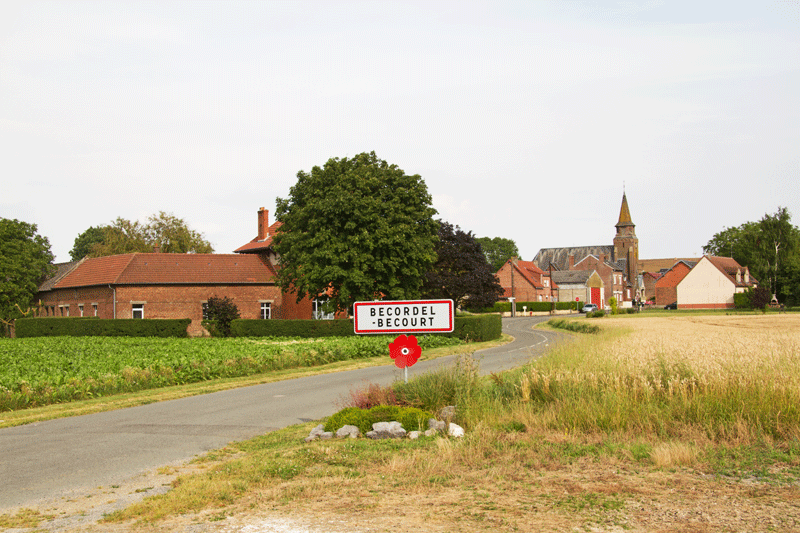
The rest of February continued "in mining fatigues under RE in firing line and on the defences of Bécordel ", until 28th February, when the 9th took over the section of the front line held by the 8th Devons opposite Fricourt; men also remained in Bécordel . One man was killed and two wounded by shellfire and rifle grenades. The following day an enemy trench raid was successfully repelled, described by John Upcott, the officer commanding no 4 company at the time, as "a most exhilarating half hour; everybody enjoys a little turn up like this after the ordinary routine of trench life. I never saw anyone so bucked as the men". Nonetheless, there were several casualties during the preceding bombardment - one man killed and 13 wounded.
March and early April continued in a similar vein - working under the Royal Engineers on the front line and in mining fatigues, while based in Bécordel and Méaulte, followed by a stint in the front line opposite Fricourt, turn and turn about with the 8th Devons. Most days there was at least one casualty, though never many - the worst day in March was 15th, when two men were killed and ten wounded. The billets were not safe - Méaulte was shelled on 19th February - John Upcott recorded in his diary that "being shelled in billets is far more beastly than being shelled in trenches and we are all getting rather nervous". On 3rd April, 2nd Lt Humphrey Cole was shot by a sniper when leaving the Tambour, and died at Corbie later in the day. He had only just arrived in France (he had joined the 9th the previous year but had remained in England when the Battalion went overseas).
On 8th April, the 9th Devons at last left behind the mining fatigues for good, to take up a new position opposite the village of Mametz, not far away (it seems that the plan for them to become the Divisional Pioneers had been changed). Together, Fricourt and Mametz formed a salient considered to be "the corner stone of the German line between the Ancre and the Somme". The two villages were (and are) on two low spurs, separated by a valley through which runs the "Willow Stream". At this point, the German line consisted of:
a maze of trenches and communication trenches twelve hundred yards in depth, and the front trench, with its many salients and flanks, was particularly well sited for defence. The villages themselves had been developed into little fortresses; there were numerous strong machine-gun emplacements and the dugouts were exceptionally fine, some of them with two storeys, lighted with electricity, and, as it was said, provided with every convenience except water. The front system was backed up by two intermediate lines .... and also by the Second and Third Positions, here respectively three and six miles behind the front line.
In contrast, the trenches the Devons had taken over left much to be desired. There was little cover, as the trenches were exposed to view from the high ground held by the Germans; there was not enough room for everyone; and the necessary infrastructure of communications trenches, stores, shelters, dressing stations etc etc was absent. In many places, bodies buried by the French, who had previously held this sector of the line, were all too near the surface. Though the Somme may previously have been quiet, it was so no longer; as they worked to improve the trenches, the 9th Devons were subjected to regular enemy fire - shelling, trench mortars, and rifle grenades. On 13th April, there was an enemy raid, though the Battalion sustained no casualties.
On 14th April, they left the trenches for billets at the village of Bray, a few miles to the south, on the Somme; but the work did not stop, as they were employed "on fatigues under RE and in the trenches". On 19th April, one of the working parties was caught up in a trench raid near Mansel Copse, where the front line ran round the tree line. The line was heavily bombarded, but the raid was repelled by the 2nd Borders, who were in the line, though at heavy cost. When the Battalion themselves took over the line two days later, the War Diary described it as "much damaged by recent bombardment". John Upcott put it more strongly: "the whole line had been blown in during the raid, except for a few square yards at the corner, where the line bends back round Mansel Copse. The rain of the last two days has turned the loosened soil into a pulp; one wades along them knee deep in liquid mud".
Much of the necessary repair to the wire could only be done at night, and on 23rd April at 9.40pm a small enemy raid followed the wiring party back to the trench, waited until they had dispersed, then entered the trench, wounded one sentry and captured another, while the other two ran for help. Consequently sentry duties were redoubled and all four companies were ordered to send wiring parties to rewire the whole front the following night. The Germans were expecting something along these lines, and while the wiring parties were out, one man was killed and seven wounded. The following night also saw a heavy bombardment from both sides. One sentry group was hit by a shell, killing two and wounding thirteen, and causing yet more damage to the trenches.
On 27th April the 9th Devons were relieved by the 2nd Gordon Highlanders; Battalion HQ and two companies went to a tented camp at Grovetown and the other two companies into billets in Bray; on 5th May, the Battalion was reunited in a bivouac at Bois du Tailles, from which they marched to a further bivouac in Treux Wood, for the purpose of training over two areas of practice trenches, supposed to be a replica of the German lines they were about to face. Though the War Diary does not mention it, other accounts say that the spring weather was beautiful, the views delightful, and the countryside lovely.
The Diary does record that a draft of 102 men joined for duty on 13th May, and Lt Col Henry Storey, who had commanded the Battalion at Loos and had been wounded, returned on 23rd May to resume command. Other new officers also joined, and more training followed. At the end of the month, the Battalion's strength was "Officers 40, ORanks 913".
On 11th June, the 9th Devons took over a different section of the front line, a little further to the east, overlooking Mametz and also their previous position at Mansel Copse. A draft of five men joined on 12th June and another sixty on 18th June. This seems to have been an extraordinarily quiet week, as all the Diary can find to say is "Bn in trenches" apart from one man being wounded on 12th June. Noel Hodgson may (as Charlotte Zeepvat suggests) have written his famous poem, "Before Action", during this time.
On 20th June the 9th Devons were relieved in the trenches by the 8th and the Battalion returned to the camp at Grovetown, where Brigade Headquarters was also located. The War Diary briefly records their preparation as the build-up for the coming offensive quickened pace:
Grovetown, 21st June: Inspection of clothing equipment etc by OC Coys. Draft inspected. Working parties detailed for work under RE in trenches.
Grovetown, 22nd June: Bn marched to billets in Bonnay.
Bonnay, 23rd June: Bn exercised over trench theatre at Vaux.
Bonnay, 24th June: Bn exercised over trench theatre at Vaux.
At this stage, the overall plan was that the advance would take place on 29th June, preceded by five days of heavy bombardment intended to obliterate enemy defences and wear down (if not eliminate) the men holding them. The bombardment therefore began on 24th June, with a concentrated barrage each morning lasting 80 minutes, followed by a steady barrage throughout the day, with half the guns rested at night.
Bonnay, 25th June: Bn marched to Bois des Tailles.
That evening there was a church parade, followed by communion for those who wished to take it. The Chaplain for the 8th and 9th Devons was Ernest Crosse.
Bois des Tailles: 26th June: Inspection of arms, equipment, clothing etc & training
Bois des Tailles: 27th June: Bn exercised in Physical training and Platoon Drill. [Two officers] wounded.
Though the War Diary does not say so, other sources state that patrols were sent from each of the attacking battalions to examine the German wire, and back into the front line trenches in the morning. In one of these patrols, the officer commanding D Company, Ralph Mockridge, was badly injured.
In addition, strongly defended machine gun posts were established to the right of 20th Brigade's position, to cover the 9th Devons advance; whilst a "Livens Large Gallery Flame Projector" was erected on the left. Unfortunately, the flamethrower was destroyed by heavy shelling in the early hours of 28th June (its remains were excavated in 2010).
Bois des Tailles: 28th June: Packs of bn stored in Divisional Store. [Two officers] joined for duty.
This was to have been the last day before the advance, but around mid-day, the advance was postponed for 48 hours.
Bois des Tailles: 29th June: Resting in Bois des Tailles
Ernest Crosse held another communion service, and Noel Hodgson (according to one of his fellow officers) read his Odyssey in the original. In the evening they built a bonfire and sat round it telling stories and singing.
The following day the attacking companies left the wood, leaving the rest in reserve. The War Diary records:
Bois des Tailles: 30th June: At 10.30pm Bn moved up to assembly trenches ... preparatory to an attack on the enemy lines.
Strength of Bn moving to assembly trenches 22 Officers 753 Other Ranks
Left in Reserve 12 Officers 308 Other Ranks including Transport.
The Plan
Please refer to our map of the action.
20th Brigade were to attack in the centre of 7th Division, with the objective of taking the western part of Mametz and form a defensive flank facing Fricourt. The 9th Devons were in the centre of 7th Division; to their right were 2nd Gordon Highlanders, to their left, 2nd Borders. The Devons had to advance in a north-westerly direction, along the western side of the valley (called Rose Valley) below Mametz, through which ran the Albert-Peronne road and a light railway. The Gordons were to advance on the eastern side. Because the road and railway were especially vulnerable to heavy machine gun fire, the valley in which the road and railway ran was left as a gap between the Devons and the Gordons. 8th Devons were the Brigade Reserve, and had to move up into the trenches vacated by 9th Devons as soon as they had gone forward.
Facing the Devons was the German front line, at this point called Danube Trench, and across the railway to the east, Mametz Trench. Behind it was Danube Support Trench, and behind that, Tirpitz Trench and Shrine Alley. Shrine Alley was a very long trench, running from the German front line at a point further west, towards the Mametz defences, and passing the village cemetery and shrine (hence its name). Shrine Alley crossed the road and railway line at the "Halt" - the stop for the village. Several German defences were concentrated at this point; in particular, a machine gun position at the Halt had an unimpeded view down the road towards the British front line - in the words of the regimental history: "One in particular, in Shrine Alley, which swept the tract round Mansel Copse ... was to prove most destructive ... It was known that this would be a danger spot, for Captain Martin ... had made a most wonderful and accurate plasticene model to assist in showing his men what lay before them". The model (which in fact showed the whole area to be attacked by 20th Brigade) had been on show at Brigade HQ at Grovetown for a number of days before the battle, and its inspection had been highly recommended to all units by Brigade staff.
Beyond Shrine Alley was "Hidden Wood", and beyond that, the Devons' final objective, the high ground on the valley between Mametz and Fricourt. Fricourt was not to be attacked directly, but "pinched out" by the 21st Division, coming from the West, and 7th Division, coming from the East, uniting in the rear and cutting it off from the rest of the German line.
Lt Col Storey's plan put No 1 Company, under Captain Martin, on the right, facing the dangers he had so clearly identified. On the left was No 2 Company, under Captain Pridham. They were to attack in two waves, with the second wave a hundred yards behind the first. No 3 Company was to provide support - to "mop up" behind the leading companies, to provide immediate reinforcement, and providing depth in the event of counter-attack. No 4 Company was the Battalion's reserve, able to move to assist where needed. Battalion Headquarters was to remain just behind the British Front line until the companies had achieved their objectives.
The British front line trench had been badly damaged by enemy shelling in the last few days, so the 9th Devons formed up in the reserve trenches, further back. This was safer, but meant that there was further to go to get to the enemy front line. By 2.35 am on 1st July, everyone was in place.
The Attack
A steady bombardment was maintained throughout the night by British artillery and the intense stage started at 6.25am. Although "zero-hour" was 7.30am, the 9th Devons and 2nd Borders, because they had extra ground to cover, went over the top three minutes before the barrage lifted.
The British barrage in this sector of the line (unlike others) was effective and had knocked out a significant number of enemy guns. However, several well-placed machine guns were still in position.
As Captain Martin's company advanced on the right from Mansel Copse, they almost immediately came under heavy machine gun fire and were largely wiped out, including Captain Martin himself, and also (according to Lt Col Storey's subsequent report to Brigade) Noel Hodgson. At 7.40am Colonel Storey ordered No 4 company forward into the hollow in No-Mans Land beyond the copse, to reinforce, and they too suffered heavy losses, including all their officers. Nonetheless, the remnants of 1 and 4 companies were able to take the German front line; but they were not able to advance further, nor to clear dug-outs or machine gun positions.
On the left, Captain Pridham's company had more success, and were able to cross No Man's Land and take Danube Trench and Danube Support with few casualties, though Captain Pridham was himself wounded. They sent their first prisoners back at 07.50am. They then came under counter-attack, and a gap opened up between them and the 2nd Borders further over to the left, who had made good progress. No 3 Company thus went forward on the left of the 9th Devons front, and successfully filled the gap.
At about the same time, Lt Col Storey received a message by telephone stating that the attack on the right was being "bombed back by parties of the enemy from Mametz". As all the 9th Devons resources were now committed, he requested reinforcements from Brigade, which were authorised. At around 10.00am (according to the 9th Devons War Diary) Lt Col Storey ordered A Company 8th Devons into the attack on the right (the 8th Devons War Diary says that A Company was ordered to attack at 10.20am and B Company 10 minutes later). They followed the same route as had 9th Devons' 1 and 4 Companies, and shared a similar fate, all the officers being either killed or wounded.
"Later in the morning", with all communication lines cut, and no runners getting through, Colonel Storey went forward to Mansel Copse himself, to discover what had happened to No 4 Coy. All officers and senior NCOs had become casualties, but he was able to find one Lance Corporal (Lance Corporal Beal) to help him collect up the remainder of the Company "who were lying in the low ground in front of the Copse". Lance Corporal Beal then took the men forward to join up with the remaining 8th Devons.
At 3.30pm, C Company of the 8th Devons were ordered to reinforce through Mansel Copse. They first took the route to the right, and the leading platoon was "badly punished" (8th Devons War Diary says the first two platoons), so the commanding officer, Lt Saville, took the rest by a route further to the left and was successful in reaching his objective and joining up with the Borders.
At 4.20pm, 2nd Lt Duff of the 8th Devons was sent out to collect up the remnants of B Company. By 5.10pm he had joined up with C Company, some of A Company, and some 9th Devons (presumably those pulled together by Lance Corporal Beal). According to the 8th Devons War Diary, this mixed group of 8th and 9th Devons under 2nd Lt Duff was able to clear a key machine gun position at the "Halte". The 8th Devons War Diary reported that "a machine gun was found at the Halte which had fired a great quantity of rounds". In the meantime, just after 4pm, the Gordon Highlanders reported that Mametz had fallen.
Thus reinforced, and with Mametz secured, the mixed group of 8th and 9th Devons were able to reach the Brigade's objective west of Mametz. At 6pm, Lt Col Storey, together with nine officers and 72 NCOs and men who had been kept in reserve out of the battle, caught up with the survivors of his Battalion, and the 8th and 9th Devons were able to link up with the 2nd Gordons on the right and the 2 Borders on the left to establish the new front. There was no German counter-attack and work started immediately to consolidate the new British line.
7th Division's attack on Mametz was one of the few successes along the Somme front on 1st July. But both Devonshire Regiment Battalions had lost heavily. The 8th Battalion lost three officers killed, with 47 men killed or missing, and seven officers and 151 men wounded. The 9th Battalion had come off rather worse. Eight officers had been killed, and nine were wounded (two of whom died of their wounds). Of the men, 141 had been killed, 55 were missing, and 267 wounded.
Burial
Meanwhile, behind the British front line, Reverend Crosse and the Battalion Medical Officer set out around 3.30pm towards Mansel Copse; in a later account he wrote: "The road was strewn with dead".
Crosse collected up all the stretchers and stretcher-bearers he could find and spent the remaining hours of daylight bringing in as many of the nearby wounded as he could find. The following day he searched the German trenches. On 3rd July he went out to begin to collect the dead from the two Devon Battalions, with a working party of fifty men. During that day and the following day, their bodies were brought in to the bottom of Mansel Copse and placed in the stretch of the old front line trench running parallel with the main road. At 6.00pm on 4th July 9th Devons, by then out of the line, along with a party from 8th Devons, paraded for a burial service for the officers and men of the 8th and 9th Devons buried there. Subsequently he erected twelve crosses in two rows, one for each plot. Each had a group of names punched in tin tape on the wooden cross. A board identified the cemetery as that of the Devonshires.
At some later date, another board, or cross, was erected with an epitaph for the men buried there: "The Devonshires held this trench: the Devonshires hold it still". A modern stone erected for the 70th anniversary of the battle now carries the same words.
Robert Phillips Willing is one of 163 burials in the Devonshire Cemetery, ten of which are unidentified. 37 of the identified burials are men of the 8th Battalion, one of whom (Lt Percy Gethin) died on 28th June 1916. All the others died in the attack on 1st July 1916. 114 of the identified burials are men of the 9th Battalion, all of whom died in the attack on 1st July 1916, including Robert. (The remaining two burials are of men from the Royal Artillery who were buried later in 1916 and in 1917).
None of the available records gives Robert's company. However, the account of the action, together with his burial in the cemetery, suggests that he was a member either of No 1 Company or No 4 Company.
Commemoration
Robert's death was not recorded in the Dartmouth Chronicle at the time. However, after the war, his name, and his brother's, were amongst those to be commemorated in Dartmouth on the Town War Memorial and the St Saviour's Memorial Board.
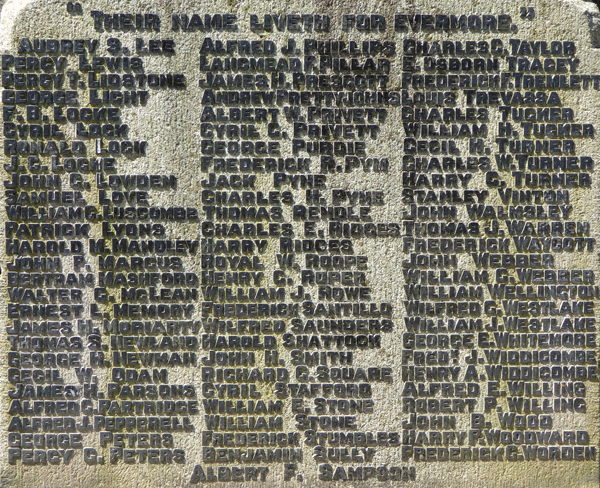
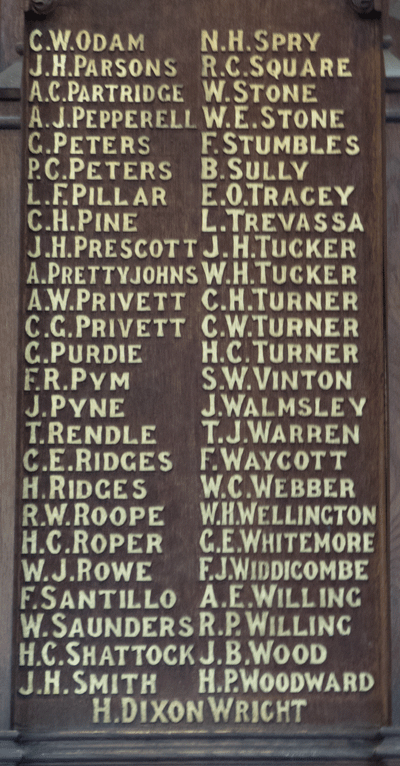
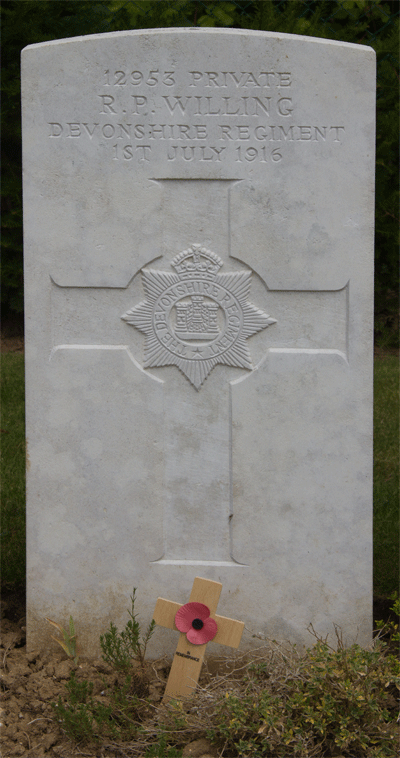
William Noel Hodgson's last poem, "Before Action", also stands as a memorial of all those who died that day, especially those in his own Battalion, with whom he lies buried in the Devonshire Cemetery:
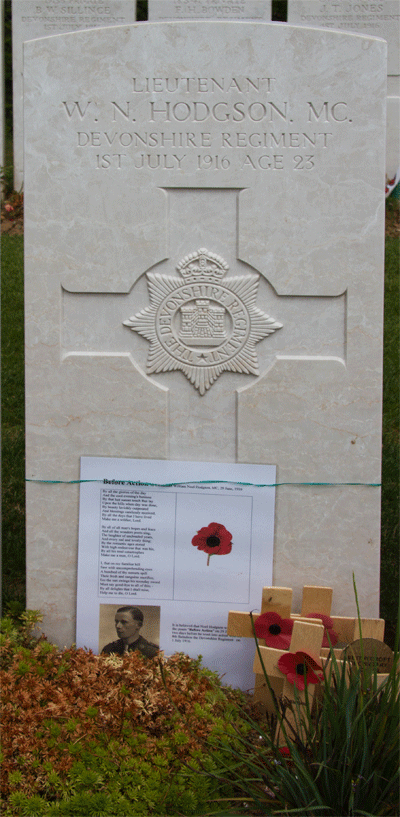
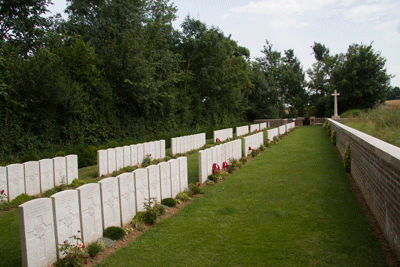
Sources
War Diaries, downloadable from the National Archives, fee payable:
- 9th Battalion Devonshire Regiment: WO 95/1656/1
- 8th Battalion Devonshire Regiment: WO 95/1655/2
- 20th Infantry Brigade Headquarters: WO 95/1653
The Devonshire Regiment 1914-1918, compiled by C T Atkinson, publ 1926, Exeter and London
Before Action: William Noel Hodgson and the 9th Devons, by Charlotte Zeepvat, publ 2015, Pen & Sword Books
West Country Regiments on the Somme, by Tim Saunders, publ 2004, Pen & Sword Books
Livens Large Gallery Flame Projector
For an overview of the Battle of the Somme, please see:
and many, many other websites and books.
Information Held on Database
| Surname: | Willing |
| Forenames: | Robert Phillips |
| Rank: | Private |
| Service Number: | 12953 |
| Military Unit: | 9th Bn Devonshire Regiment |
| Date of Death: | 01 Jul 1916 |
| Age at Death: | 23 |
| Cause of Death: | Killed in action |
| Action Resulting in Death: | Battle of the Somme |
| Place of Death: | |
| Place of Burial: | Buried Devonshire Cemetery, Mametz, France |
| Born or Lived in Dartmouth? | Yes |
| On Dartmouth War Memorial? | Yes |
| On St Saviour's Memorials? | Yes |
| On St Petrox Memorials? | No |
| On Flavel Church Memorials? | No |
| In Longcross Cemetery? | No |
| In St Clement's Churchyard? | No |
| On a Private Memorial? | No |
| On Another Memorial? | No |















